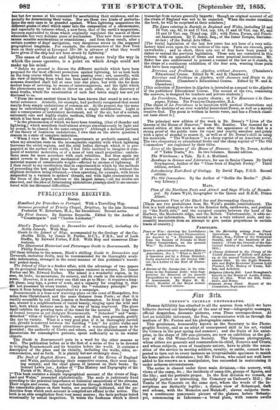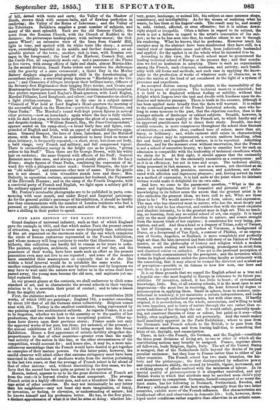Ina 3rt5.
PENTON'S CRIMEAN PHOTORRAPHS.
Human fallibility has attached to all the sources from which we have hitherto derived our knowledge of the seat of war—telegraphic messages, official despatches, dioramic pictures, even Times correspondence. At last an infallible informant, the Sun, communicates with us through the medium of Mr. Fenton and his photographic camera.
This gentleman, honourably known as the Secretary to the Photo- graphic Society, and as an adept of unsurpassed skill in his art, visited the Crimea in the past spring and summer; and the fruits of his enter- prise, in the shape of 280 sun-pictures, are now on exhibition at the gal- lery of the Old Water-Colour Society. The Crimean photographer, whose sitters are generals and commanders-in-chief, Zouaves and Croats, and whose subjects, even of inanimate nature, have to abide the neces- sities of the service in moving soldiers, cavalry, or cattle, cannot be ex- pected to turn out in every instance an irreproachable specimen to match his home pieces de resistance; but Mr. Fenton, who could not well have added to his renown as a manipulator, has succeeded in maintaining it under arduous circumstances.
The series is classed under three main divisions,—the scenery, with views of the camp, &c. ; the incidents of camp-life, groups of figures, and the like ; and the portraits proper. In the first division we remark, as specially perfect or interesting, the Cemetery on Cathcart's Hill ; the Tombs of the Generals on the same spot, where the words of the in- scriptions are distinctly legible ; a distant view of Sebastopol, dark and solemn, with the Mamelon and Malakoff; eleven subjects form- ing a continuous panoramic picture of the plateau before Sebasto- pol, commencing at Inkerman—a broad plain, with remote swells of hill, dotted with tents and carts ; the Valley of the Shadow of Death, strewn thick with cannon-balls, and of flawless perfection in rendering; the Valley of the Ruins of Inkerman ; and the Valley of the Tchemaya. Balaklava supplies a great number of subjects, and many of the most splendid. Such are the old Genoese Castle; the town from the Russian Church, with the Church of Kadikoi in the distance ; the picturesque landing-place, with railway-Morel; the Ord- nance Wharf ; an extensive view of the lines from Guards' Hill, light in tone, and spotted with its white tents like sheep ; a second view, exceedingly beautiful in its middle and further distance ; an ad- mirable picture of the town; another, rich in tone, with Russian cot- tages in the foreground ; the head of the Harbour, Cossack Bay, and the Castle Pier, all exquisitely made out; and a panorama of the Plains in five views, with strong effects of light and shade, almost Martin-like. In the second division, Ismail Pasha orders and receives his chibouque with the gravity of a state ceremonial ; a Quiet Day in the Mortar Battery displays singular photographic skill in the foreshortening of recumbent soldiers ; a convivial group figures as "Hardships in the Cri- mea " ; and Chasseurs d'Afrique interpose their brilliant tenue, Officers of the Seventy-first Highlanders their begging Skye terrier, and Croats and Montenegrins their picturesqueness. The third division is liberally supplied. One picture represents Lord Raglan's Head-quarters, with Lord Raglan, Marshal Pelissier, Lord Burghersh, and others ; our Commander-in-chief in a light civilian-costume. The same is the case in a subject named "Council of War held at Lord Raglan's Head-quarters the morning of the successful attack on the Mamelon—portreits a Raglan, Pelissier, and Omar Pasha." The Marshal's round well-kept person figures in sevei al other pictures,—now on horseback ; again where the face is fully visible with its dark hot eyes, wherein lurks perhaps the ghost of a squint, severe and despotic-looking. "William Russell, Esq., the Times Correspondent," appears seated on his camp-stool,—a broad burly face and figure, com- pounded of English and Irish, with an aspect of splendid digestive appa- ratus. General Bosquet, the hero of Alma, Inkerman, and the Malakoff storm, with whom Mr. Fenton is understood to have lived on terms of close intimacy, is frequently repeated,—a short, stout, but clean-cut body, a bald visage, very French and military, and full compressed vigour. There is extraordinary energy in the bright eye as he points, "giving orders to his Staff." Then there are Sir George Brown, with his white hair en cockatoo ; the same General with officers of his Staff; General Estecturt more than once, and always a good steady sitter ; Sir De Lacy Evans ; single figures of Omar Pasha, combining the expression of in- ward fire with a phlegmatic outer mask ; General Simpson, the type of an "old soldier" ; and numerous other men of name. Even the gentle sex is not absent. A trim vivandiere stands here and there ; Mrs. Dnberly, in equestrian costume, accompanies her husband, the Paymaster of the .EleventhHussars; and in the camp of the Fourth Dragoons, with a convivial party of French and English, we light upon a solitary girl in the ordinary apparel of womankind.
lfr. Fenton's invaluable photographs are to be published in parts, com- mencing with next month, and under Royal and Imperial patronage. As for the general public's patronage of his exhibition, it should be hardly less than commensurate with the number of London residents who feel a personal or public interest in the scenes and actors of the war, and who have a shilling in their pocket to spend.



























 Previous page
Previous page